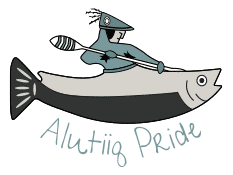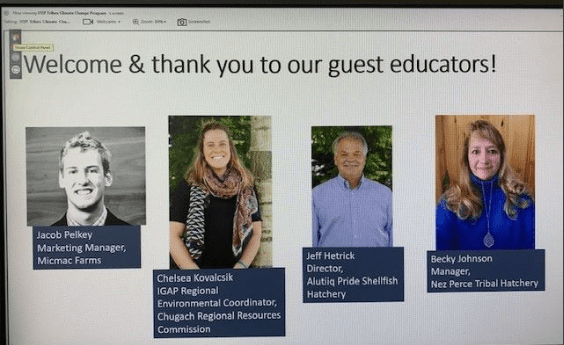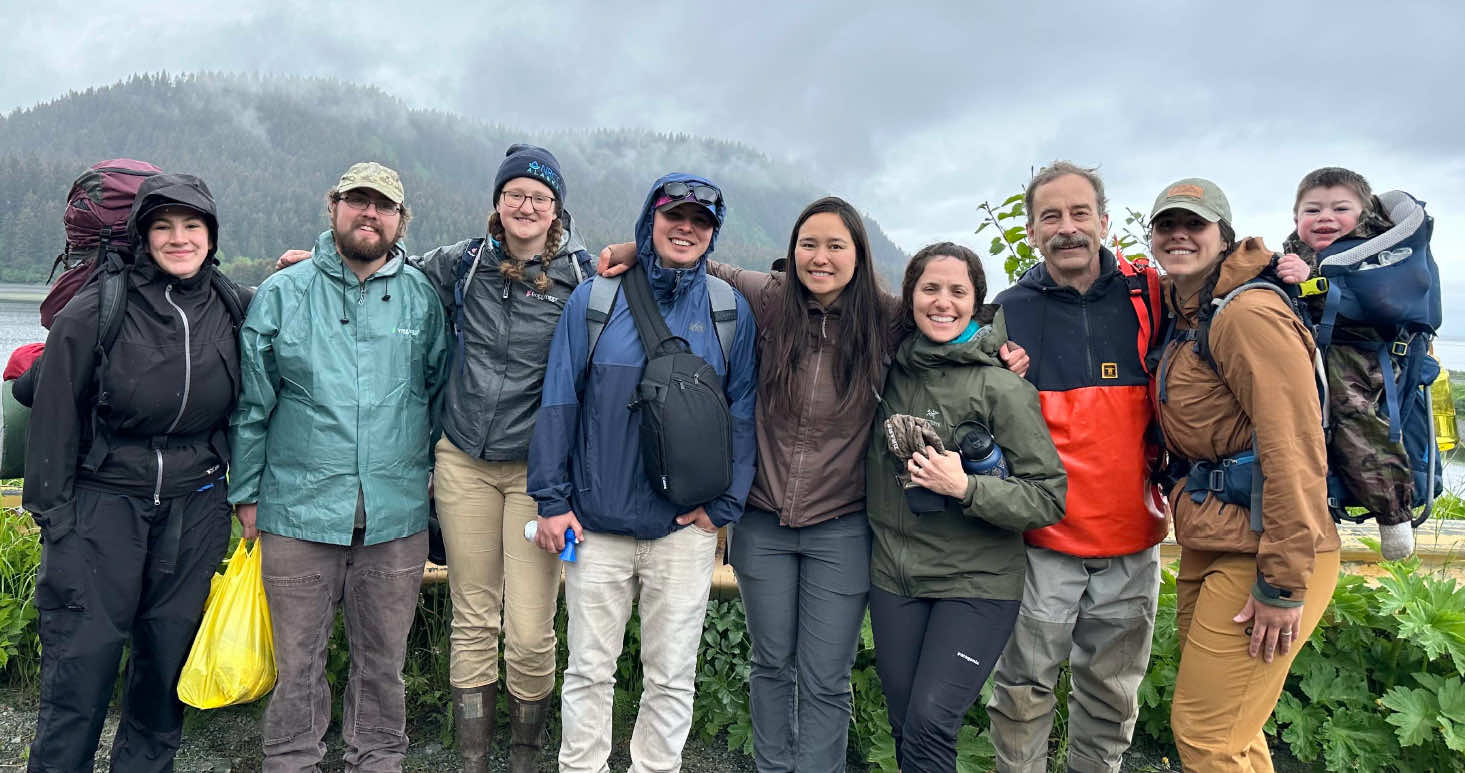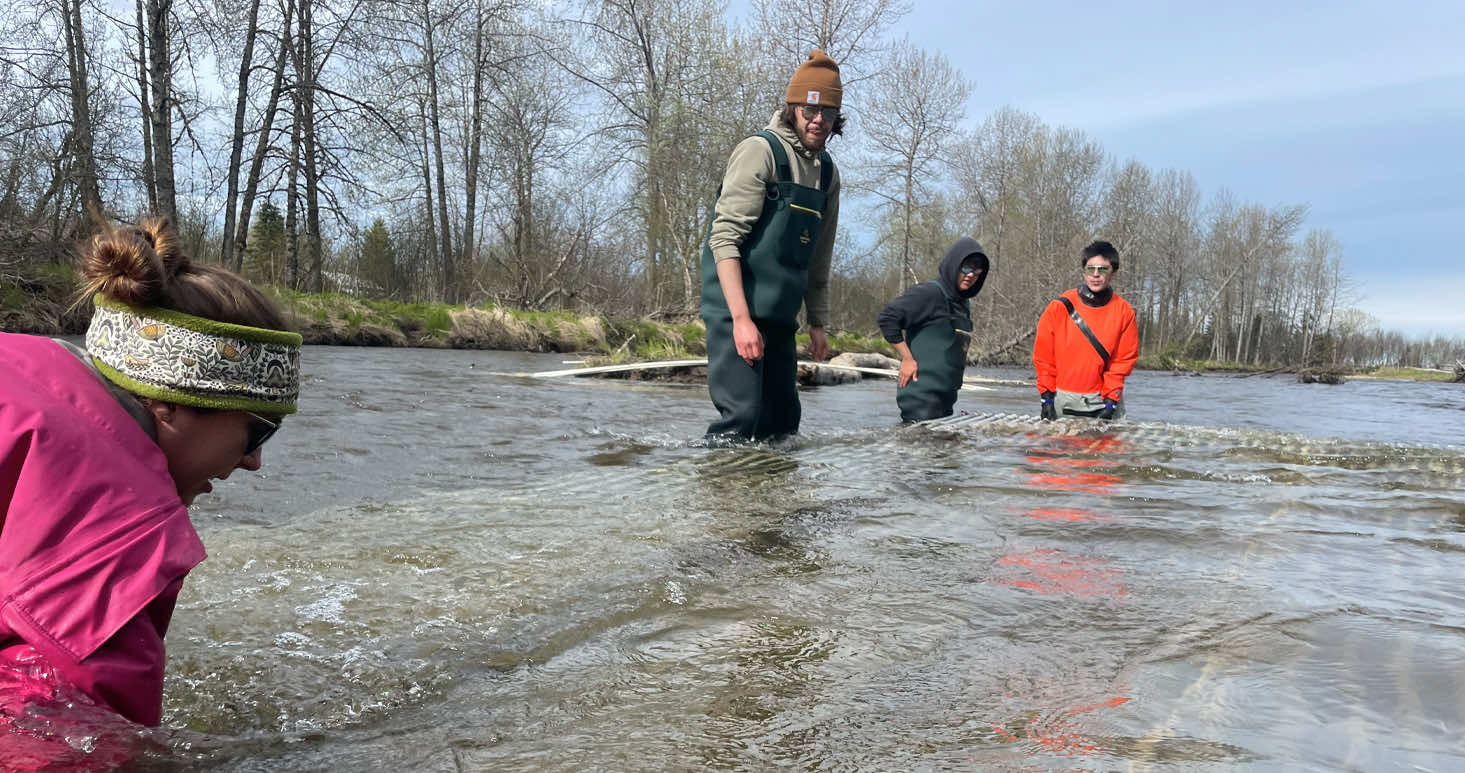CRRC 2020 Q2 Newsletter

CRRC has been busy these last few months! Take a look below to see what staff have been up to. We also include other regional and noteworthy news.
In lieu of visiting Nanwalek during Sea Week in early May, we created this video for the youth to watch so they can learn about the Alutiiq Pride Shellfish Hatchery in Seward and all the fun ‘sea’ things we do.

Greetings! I am pleased to send my first newsletter as the Executive Director of CRRC. As many you of know, Patty Schwalenberg retired at the end of December, 2019 which hasn’t worked as well as she planned because of her deep ties to the people of the Chugach and her relentless work ethic. She is still with CRRC as the Executive Director of the Alaska Migratory Bird Co-Management Council and we are thankful every day we continue to have her a resource and especially to provide guidance to our young staff.
Many of you may not know that I have been working with and for CRRC in some capacity since 2006. Aside from years of hearing about the organization from my father, Jeff Hetrick, Director of the Alutiiq Pride Shellfish Hatchery (Hatchery) coupled with many tag-alongs to all CRRC communities as a youngster, I completed my Master’s thesis in 2006 at the Hatchery studying the significance of red king crab habitat for survival in an attempt to better understand why populations were declining despite fishing bans. At the same time, I continued my coursework in Public Administration by analyzing all of the community Natural Resource Management Plans to highlight common themes for CRRC to address to ensure maximum impact for our Tribes.
Between 2006 and 2017, I worked as a contract grant writer/biologist for the organization which afforded me insight into the operations of all granting agencies as well as CRRC and its programs and priorities. During this time, we were able to secure over $1.5 million dollars in grant funding, and counting! During times of low staff, I quickly became the contractor tasked with implementing the grant requirements. In 2017, CRRC was successful in receiving an EPA Indian General Assistance Program grant that provided funding for me to be on staff full time. Soon after, I moved into the Deputy Director position and even sooner after that to the Executive Director.
When my parents brought me home from the hospital after I was born, it was to a small fish hatchery in the Prince William Sound. The Chugach region is my home, it’s where I live, work and play. It’s where I want my children to have the opportunity to grow up like I did: catching and eating salmon in Resurrection Bay, hunting and eating moose and caribou from the Kenai Peninsula, and picking and eating berries from the Sound. Rest assured that I have one, overarching goal in my new role: protect the ways of a subsistence lifestyle in the Chugach while allowing for the growth of the people and the protection of the environment.
Thank you for giving me the opportunity to lead this great organization. We are looking forward to building our capacity and expanding our base operations and services that we can provide to the people of the Chugach.
COVID: CRRC continues to monitor the status of the COVID virus and is taking actions to protect our employees. CRRC is fortunate that with only 6 direct employees in Anchorage and 3 in Seward we can generally practice social distancing. CRRC is allowing non-essential employees to work from home until we know more about the implications of the virus. Please understand that it may take office staff longer than normal to reply to emails and phone calls. Stay healthy!

CRRC Update on the
19th Annual Subsistence Memorial Gathering

Current worldwide concern over the COVID-19 paired with the State of Emergency Declaration by Alaska Governor Dunleavy requires a reexamination of major annual events. An abundance of caution has led the Chugach Regional Resources Commission to postpone the 19th Annual Subsistence Memorial Gathering until further notice. CRRC hopes that everyone stays safe and practices responsible health measures at this time.
CRRC’s Climate Vulnerability Assessment Project

This project comes from the BIA’s Tribal Resilience grants for Ocean and Coastal Management Planning and is phase II of CRRC’s three-phase Adaptation Planning Project, initiated in 2013 at the request of CRRC’s Board of Directors. Phase II, a vulnerability assessment to identify at-risk and understudied resources of high cultural value, will help CRRC and member Tribes better understand how climate change could impact resources and livelihoods, as well as identify research needs and priorities. These visits to CRRC’s member tribes are meant to gather observations, listen to concerns, and identify areas of inquiries, all of which will be incorporated into the regional vulnerability report and used to develop adaptation plans during Phase III of the Adaptation Planning Project. We thank the Council, students, teachers and community members who have provided input and shared observations. These will provide a better understanding of the risks the Chugach region faces regarding climate change and the changes community members are already observing.
On Tuesday, December 17th, Willow, Chelsea, Erin and Rachel traveled from Anchorage to Port Graham. Chelsea, Erin and Rachel visited the Port Graham school during the first day to give lessons on the topic of food webs. The lessons between age groups differed in method but remained consistent in content, asking what are the impact of climate change on subsistence resources and how does that impact the rest of the food web. The elementary students participated in a coloring activity of the subsistence foods poster CRRC commissioned in 2017. Following this warm-up activity, elementary students learned about the food web by making one, each student playing the role of a different animal, then discussed what happened when those important links between different species were severed. The middle school students discussed observations about resources in their community and participated in an interactive food web activity. When the high school students joined the middle school class, the lesson shifted to a discussion on solutions and what students can do in their own community to fight climate change.

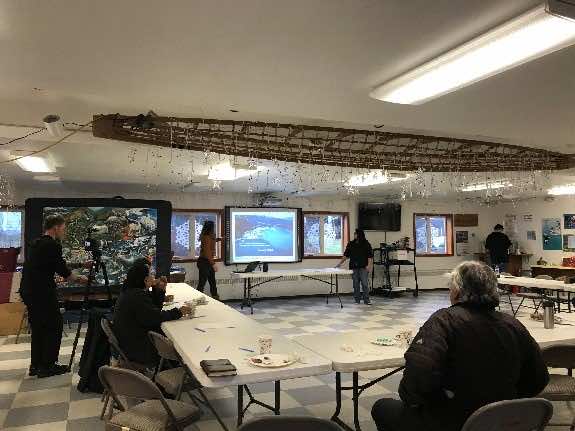
Later that day, Willow, Chelsea, Erin and Rachel from CRRC along with Syverine Bentz from the Kachemak Bay National Estuarine Research Reserve (KBNERR) and Nathan Lojewski from the Forestry department of Chugachmiut all attended the Port Graham council meeting. The group gave three presentations, followed by an interactive discussion led by Willow. Chelsea and Naomi McMullen, Port Graham’s IGAP representative, presented on the Alutiiq Pride Shellfish Hatchery’s ocean acidification monitoring program. Syverine presented an overview of KBNERR’s work and Nathan presented on efforts to combat invasive species such as the spruce bark beetle and discussed how current understandings of how climate change is likely to impact forests in the region. Willow used CRRC’s subsistence foods poster to facilitate a discussion amongst Council members on their observations and concerns regarding subsistence resources and the local environment. During this discussion, Willow asked council members to provide insight into the subsistence resources they see in their region and if they’ve noticed changes in their abundance, timing, size, and more. These observations were translated into green, yellow or red indicators meant to convey intensity of concern. On the day following the council meeting, CRRC hosted an open house in the Port Graham Community Center. This open house was intended to gain further insight into the discussion Willow facilitated at the Council meeting on subsistence resources and their perceived vulnerability to climate change.
Chenega
On Wednesday, February 19TH, Chelsea, Erin and Rachel traveled from Anchorage to Chenega. During this five-day visit, CRRC staff hosted an open house at the community center and taught lessons at the school. Their first stop was to visit the Chenega school to discuss food webs, changing climates, and ocean acidification with the students. The three led an interactive lesson on food webs with reference to subsistence foods. This lesson was meant to teach that different species and ecosystems are tied to one another and that when a process is impacted by a changing climate there are ripple effects throughout the system. Several students were out on vacation so the class size was very small, which merely allowed Chelsea, Erin and Rachel the opportunity to teach the lesson with the students rather than to the students. The students were very engaged, demonstrated prior knowledge on the subject of climate change and were eager to brainstorm solutions.

The following day Chelsea, Erin and Rachel hosted an open house at the Chenega Community Center for any and all community members to attend. The three prepared dinner for all attendees to have while Chelsea led a discussion on subsistence resources in the region and perceived vulnerability of said resource to climate change. During this discussion, Chelsea stood at the front of the room in front of the subsistence foods poster, and asked the group about broad categories of subsistence resources like “terrestrial mammals.” Chenega community members identified specific species they were concerned or not concerned about and provided a brief explanation as well as a ranking of green, yellow, or red to indicate intensity of concern. Due to inclement weather, CRRC staff members were unable to return to Anchorage as scheduled on Friday, February 21st and stayed in Chenega until Sunday, February 23rd. During this time, CRRC staff worked remotely, explored the region, and attended community movie nights and made an effort to connect with Chenega community members.

Qutekcak/Seward
Willow, Chelsea, Erin and Rachel visited the Qutekcak Native Tribe Administrative Building on March 3rd to host another open house. The four arrived several hours early in order to attend a beading class taught by Leona. This event saw quite a handful of people show up to discuss climate impacts they are seeing in their region. As usual, CRRC staff provided a meal of salmon and facilitated a discussion amongst the attendees. One notable theme that the Seward community continued to return to, that was emphasized more at this open house than the others, was a connection between environmental and economic health. Several participants were business owners or employees of companies that rely on eco-tourism, other participants, though not business owners still emphasized this notion with regards to fishing and other harvests. With Aialik glacier retreating and subsequently sea lion habitat shrinking, the owners of Kayak Adventures Worldwide are worried about the consequences these environmental changes will have on the demand for their services.


water quality sampling program. This photo was taken at the docks in Port Graham.

Tribal Climate Camp (TCC)
Purpose
Native communities are among the most climate-sensitive groups within the Northwest, Southern and Eastern regions of the United States. Increasing the resilience of tribal governments and native communities is critical to prepare for future climate change scenarios. The overall goal of TCC is to build the capacity of tribal leader teams to address climate change and associated economic, social, cultural, regulatory, and technological trends and impacts through strategic alliances with partners across Indian Country and globally. TCC is designed for early career tribal environmental professionals who have been assigned with some level of responsibility for leading a climate change program.
1. Develop specific plans of action for building Tribal climate change programming in their Tribes that is responsive to the concerns of the Tribal community regarding climate change;
If you are interested in attending the 2020 Tribal Climate Camp, and are a member of the Native Village of Port Graham, the Valdez Native Tribe, the Native Village of Nanwalek, the Native Village of Eyak, the Qutekcak Native Village, the Native Village of Chenega or the Native Village of Tatitlek, apply here!
EPA Wetland Program Plan
CRRC is working on creating a Wetland Program Plan, funded by the EPA. The Wetland Program Plan details the implementation of effective wetland conservation, restoration, and management. This plan will put in place action items and a procedure for the mapping of wetlands in the Chugach region (specific to CRRC tribes only). In addition to the wetland program plan development, we have money to map existing wetlands in the region using geographic information systems (GIS) and contracted Tricia Saulnier Littlejohn, DBA Aurora GIS, to create these maps.
~We want feedback from YOU on the wetlands in your region~

On Friday, January 31, CRRC attended the Chugach Regional Summit hosted by the Chugach corporation. The Summit focused on collaboration between various entities that provide services and economic opportunities in the region. The morning started with a discussion of the upcoming Chugach Region Land Study called for under the 2019 Dingell Act. Chugach Alaska Corporation is hoping to use this study as an opportunity to revisit some of the land exchanges that occurred after the Exxon Valdez Oil Spill (EVOS), as well as to finally settle outstanding land claims from ANCSA. More specifically, the Chugach Alaska Corporation plans to continue advocating for a land exchange that gives Alaska Native Corporations full control over their land, as right now many corporations only have subsurface rights to the land.
Chelsea Kovalcsik and Rachel Fischer presented CRRC’s work on encouraging and training tribal members to get involved in regulatory processes regarding subsistence resources. They discussed a workshop CRRC hosted in March of last year that provided an introduction to the Board of Game (BoG) processes, held in conjunction with the 2019 BoG Regular Southcentral Meeting.
A youth panel presented topics important to their communities where youth from Port Graham, Tatitlek and Valdez expressed concerns with the group. These varied from desires for mentorship to help youth get outdoors and learn traditional ways of gathering food and frustration with the impact drugs and alcohol have on young people’s connection to culture.
The afternoon consisted of report-outs from regional Native Villages regarding work in their communities. Erin Shew joined the Business Development Regional Brainstorming session where a topic of interest was the potential for mariculture. Entry to mariculture in the region was described as a challenge as the group discussed was the complexity of the permitting process, identifying the potential for the Alutiiq Pride Shellfish Hatchery to partner in mariculture feasibility studies with interested villages.



In December one of our VISTA members, Rachel, had the opportunity to attend an Americorps training in Phoenix. At this training, Rachel was able to connect with VISTA members across the country, share experiences and stories with individuals working towards similar goals, and attend courses intended to develop professional skills like grant writing, creating partnerships, and resource development. One notable session Rachel attended during this four-day training was title “Engaging the Community Using an Asset-Based Approach.” In this session, asset was defined not in monetary terms but in terms of social capital. Here, social capital and “assets” are viewed as practices, places, knowledge, non-monetary resources, and relationships that benefit and strengthen the community. The broad goal of this session was to shift from a deficit-based perspective to an asset-based perspective where one focuses not on problems but on opportunity. One idea that Rachel took away from this session would be to use her background in GIS and the recent GIS training she took with the BIA to create asset maps for the CRRC communities concerning natural resources.
Native Village of Tazlina Seeks Help to
Protect Traditional Copper River Fishing Grounds
Native Village of Tazlina
P.O. Box 87
Glennallen, AK 99588
Press Release January 24, 2020 Native Village of Tazlina, Glennallen Alaska
Media Contact: Heide Lingenfelter, Administrator, Native Village of Tazlina 907-822-4375
The Native Village of Tazlina Tribal Council is raising funds to purchase a 462-acre parcel of property at the confluence of the Copper and Tazlina River to protect ancient village sites and tribal fishing grounds. Gloria Stickwan, President of the Native Village of Tazlina stated. “The Tazlina Village Council goal is to protect these fishing sites, and we want to sustain fisheries in the Copper River. If this land is sold, our fishing sites will be taken away from tribal members.” The area is the former site of the Copper Valley Catholic Boarding School which operated from 1956 to 1971 and is a reclaimed brownfield.
Under, the Presidential leadership of the late Johnny Goodlataw, a community-based stewardship vision for the area was developed. The plan includes protecting traditional fishing grounds/village sites, developing a tribal College, cultural center/museum, community hall, recreation area/playground, community garden, and church; as well as preservation of cultural resources, fisheries research and future riverbank erosion mitigation.
On January 23, 2020 as soon as he heard about it, Robert Henrichs former president of the Native Village of Eyak and Chair of the Alaska Village Initiatives donated $1,000 to the cause. Bruce and Shirley Cain, formerly of Cordova joined Henrichs with a $1,000 contribution of their own. Henrichs, and the Cain’s encourage others to join them with support for the effort.
Donations can be sent to the Native Village of Tazlina Land Fund P.O. Box 87, Glennallen Alaska 99588. More information about the campaign can be found by contacting the Native Village of Tazlina at 907-822-4375. P.O. Box 87 Glennallen Alaska 99588 or emailing Heide Lingenfelter, Tribal Administrator Native Village of Tazlina at prog.mang.@gmail.com.

Robert Henrichs, Chairman of Alaska Village Initiatives presents a personal donation of $1,000 to the Native Village of Tazlina Land Fund to go towards protection of former tribal village sites and fishing grounds. Left to Right, Dorothy Shinn, Secretary, Native Village of Tazlina, Gloria Stickwan, President, Native Village of Tazlina, Heide Lingenfelter, Administrator, Native Village of Tazlina, Henrichs.
Introducing Chugach Regional Resources Commission’s new segment:
CRRC’s “Least Wanted” List!

This quarter on CRRC’s Least Wanted list is… Spruce Bark Beetle!
Potential Impacts/Identification
- Following a successful spruce beetle attack, you will notice needle discoloration as the needles will change from healthy green, to faded yellow, and finally to red before the needles eventually drop.
- Boring dust is a brown sawdust like material that collects at the base of a tree and in bark cervices as adult beetles excavate and clear spaces beneath the bark.
- Pitch tubes appear as reddish globules on the bark’s surface and are the trees attempt to push out invaders.
- Woodpeckers are attracted to the beetle infested trees and will peck and scrape at the bark to find beetles beneath it, this will leave behind flakes at the base of the tree.
- After beetle attacks, the trees will dry out and bark will become loose and fall off.

There are different management techniques for single tree protections and management versus forest-scale management practices. Areas of actions include monitoring, pesticides, maintaining tree/stand health, forest management. Individual landowners can remove infested trees before beetles emerge in late spring, but should avoid cutting trees during that time.
REPORT IT!
1-877-INVASIV (468-2748)
or contact Dan Coleman
Invasive Weeds and Agricultural Pest Coordinator
1-907-745-8721

Voices of the Kenai
Middle Kuskokwim Adaptation Planning


Sugt’stun word of the week:
Chugach Regional Resources Commission is dedicated to the cultural preservation and Tribal sovereignty of the Tribes of the Chugach Region.
By promoting the use and preservation of the Sugt’stun language, which holds embedded cultural meaning and customs that may not translate, Tribal Members can assert their Tribal Sovereignty over their resources, their lands, their traditions, and ultimately, their way of life. Traditional language is central to cultural and spiritual traditions.
Sugt’stun = Suistaq
English = Nativity Caroling Star
Sentence in Sugt’stun = Suistaq sug’et cungairtarlan’tat itraqan enegnun taumi an’aqan enegnek
Sentence in English = People don’t go in front of the star when they’re going into houses and when they leave the houses.
Translated by: Casey Marsh
Sugt’stun = Slaawiq
English = Christmas Caroling
Sentence in Sugt’stun = Slaawilriit akgulipia, amlerpaka en’et
Sentence in English = They caroled all through the night because there were so many houses.
Translated by: Casey Marsh
Sugt’stun = Nuwikutaq
English = New Year’s Celebration
Sentence in Sugt’stun = Peknertulartuq paigneq Nuwikutame
Sentence in English = The preparation for New Year’s Celebration is a lot of work.
Translated by: Casey Marsh
Sugt’stun = Kankiq
English = Ice skate
Sentence in Sugt’stun = Kita am cikuli nanwaq, uspia kankiryuumirtua
Sentence in English = I wish the lake would hurry up and freeze. I really want to ice skate.
Translated by: Casey Marsh
“Sugt’stun is the traditional language of the Sugpiaq communities across the Alaska Peninsula, Prince William Sound and Kodiak Island. This includes the villages of Port Graham and Nanwalek. Nanwalek residents Sally and Sperry Ash have collaborated with KBBI to share the Sugt’stun language with the communities of the southern Kenai Peninsula. A new word will air each week, twice a day. You can hear the Sugt’stun Word of the Week on weekdays at 7:59 a.m. and 4:59 p.m. and weekends at 9:18 a.m. and 4:18 p.m.” – KBBI.org

Chelsea Kovalcsik, Chugach Regional Resources Commission’s IGAP Regional Environmental Coordinator, attended the Alaska Marine Science Symposium in Anchorage from January 28-30, 2020 at the Hotel Captain Cook. The Alaska Marine Science Symposium (AMSS), Alaska’s premier marine research conference, has been bringing together scientists, educators, resource managers, students, and interested public for over twenty years to discuss the latest marine research being conducted in Alaskan waters. Over 700 people attend this 4-day long conference held annually during the month of January.
Each day of the conference highlights important Alaskan marine ecosystems: Gulf of Alaska (Tuesday), Bering Sea & Aleutian Islands (Wednesday), and the Arctic (Thursday). Research topics discussed range from ocean physics, fishes and invertebrates, seabirds, marine mammals, to local traditional knowledge.
Some key presentations from Tuesday’s Gulf of Alaska session were on harmful algal blooms and ocean acidification. With CRRC’s work at the Alutiiq Pride Shellfish Hatchery leading the way for OA research in Southcentral Alaska, these presentations were good opportunities for Chelsea to network with fellow researchers as well as receive updates on their work. In the evening of the 28th, Chelsea also attended an “Ocean Acidification Town Hall” which included five-minute updates from OA researchers ranging from open ocean and nearshore monitoring to species response in the lab. After the updates, the floor was opened up for a Q&A and discussion. Chelsea met with Wiley Evans, Marina Washburn, and other IGAP coordinators from around the state to discuss OA within their communities and to find better ways to bridge the gap between native communities and western science. Chelsea has also recently added harmful algal blooms to her FY21 IGAP work plan so getting a chance to attend these presentations were of tremendous value for her in planning for the next fiscal year.
This is Chelsea’s third year attending the Alaska Marine Science Symposium. She plans to continue attending the conference in the future and hopes that one day she will be on the stage presenting her work with CRRC and APSH to other marine scientists.

The Alutiiq Pride Shellfish Hatchery was invited to present on a webinar titled: Tribal Fish Hatcheries and Climate Change Adaptation. The webinar is an installment of the Topics in Climate Change Adaptation Planning webinar series hosted by the Institute for Tribal Environment Professions (ITEP) Tribes and Climate Change Program.
Chelsea Kovalcsik, Chugach Regional Resources Commission’s IGAP Regional Environmental Coordinator, discussed ways in which the Alutiiq Pride Shellfish Hatchery (APSH) is combatting climate change through shellfish aquaculture and enhancement and through their unique ocean water dosing project, which directly addresses ocean acidification impacts on shellfish larval growth and development. APSH has developed a citizen science monitoring program that allows communities around the state of Alaska to sample nearshore ocean chemistry and help create long-term data sets with that information.
Through ongoing funding, APSH trains Tribal Members to collect nearshore water samples within their communities. They sample once a week, same time and same place, and send the samples to the hatchery for testing using our Burke-o-Lator. Just like the Burke-o-Lator can test water right outside the hatchery, it can also test discreet samples from communities. APSH sends participating communities a kit that contains everything they need for sampling and also pays for shipping costs and any materials/training samplers may need. Samplers follow established protocols using APSH produced field kits.
You can view the full webinar, here!
Improve Nutrition and Health

“…CRRC is a leader in Tribal Natural Resources in Alaska. As such the organization leads local projects surrounding research, education, economic development, and enhancement of subsistence species.
One project involves the region’s traditional foods – how accessible they are, how important they are, how they are being used, and what needs to be done to protect and manage them. With a belief that “food is life,” the CRRC sought funding through First Nation’s Native Agriculture and Food Systems Initiative to conduct data analysis and a workshop.
The grant funding kicked off with a four-day training on food assessments hosted by First Nations, which Hetrick says gave all grantees a baseline start on best practices.
“They believed in us,” she says, “And they put us in touch with a program officer who really understood the intricacies of working in a rural, offset region like Alaska.”
From there, the CRRC set out to design, distribute and collect food surveys from over 100 respondents to provide a high-level analysis of the situation. Their food assessment collection tool was unique in that it focused not just on consumption, but on food as a whole, explains Hetrick.”
Read the full story, here!
The CRCC earned the 2019 Arts and Humanities Award in the field of Distinguished Service to Education from the Governor of Alaska. Pictured here with the award are: (From left to right) Kelly Tshibaka, Commissioner of the Alaska Department of Administration; Patty Schwalenberg, former Executive Director of CRRC; Robert Heinrichs, current CRRC Board Member from the Native Village of Eyak; and Beth Pipkin, former Board member from the Chenega IRA Council.
Shellfish Growers For Climate Action



Chugach Regional Resources Commission (CRRC) recently received a $80,000 grant from the First Nations Development Institute (FNDI) of Longmont, Colorado. This award will support the efforts of CRRC’s initiative titled: “Chugach Hunting, Fishing, and Gathering Taskforce – Empowering our People, Encouraging Involvement, Changing Regulations.”
Estimated Expenditures on Invasive Species by
Ontario Municipalities & Conservation Authorities



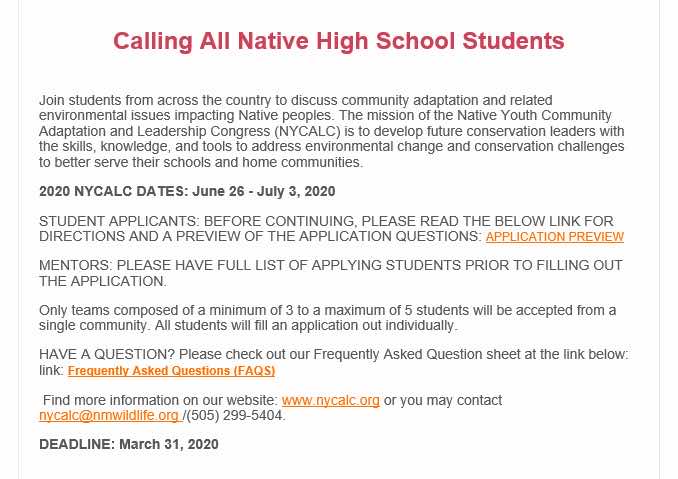

Student Summer Internship (SSI) Program
Since 1994, the Institute for Tribal Environmental Professionals (ITEP) has offered student summer internships for Native American and other college students with funding from the U.S. Environmental Protection Agency (USEPA). This program provides the opportunity for students to gain hands-on skills with EPA or other governmental and tribal environmental offices.
For more information, please contact:
Mansel Nelson
928-523-1275
To learn more about potential summer internships, click here!




Interested in what CRRC is up to these next couple of months? Take a look at our calendar and stay up-to-date. Hopefully we will see you around!




